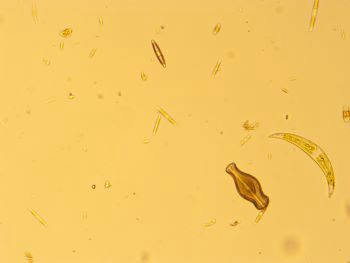Privately-operated fish hatchery on Au Sable River inspected for invasive species

Last week, the Michigan departments of Natural Resources, Environmental Quality and Agriculture and Rural Development jointly inspected the Grayling Fish Hatchery located on the East Branch of the Au Sable River in Crawford County.The inspection was conducted following the discovery in June of New Zealand mudsnails immediately upstream and New Zealand mudsnails downstream of the privately-operated hatchery. New Zealand mudsnails compete with native snails and other macroinvertebrates that trout may eat.
Inspection of the Grayling Hatchery followed a letter from the hatchery’s operator, which invited the three state agencies into the facility to conduct an inspection, and to review procedures the hatchery has instituted to reduce the risk of spreading the invasive snails.
In July, the DNR required risk reduction procedures to the hatchery owner in order for him to be able to stock fish in public waters. The owner independently also implemented additional risk reduction practices, including use of well water for fish transport. The inspection last week confirmed a source of well water is available to the hatchery for use in trucks transporting fish. Use of this specific source of well water ensures invasive snails are not leaving the property in river water.
With well water being used for fish transport, the remaining required practice to implement – which aligns with industry standard – is to hold fish for no more than 36 hours without food before transporting them. The 36-hour maximum no feed period is designed to minimize the possibility fish will feed on snails and move them elsewhere, even though snails are not a preferred food source for trout.
The on-site inspection also included surveys for New Zealand mudsnails within the facility. A small number of specimens presumed to be New Zealand mudsnails were collected from the walls of the hatchery’s raceways, where trout are reared for the purposes of stocking in other waters and harvesting for market.
Results of genetic testing are expected by the end of this week to confirm if those specimens are indeed New Zealand mudsnails.
Some 60 fish were dissected to look for the presence of New Zealand mudsnails in the fishes’ digestive tracts. No invasive snails were discovered in the dissected fish.
“It is not surprising to find a limited number of presumed New Zealand mudsnails in the hatchery raceways, given their presence in the river system,” said Ed Eisch, the DNR’s fish production manager. “The important thing is to minimize, as much as possible, the spread of these snails through the hatchery’s actions or by the actions of others who use the river. Our inspection confirms actions taken at the Grayling Hatchery – actions that were put in place by DNR back in July following the discovery of this invasive species – are indeed appropriate, effective measures.”
The three state agencies will continue to work with the Grayling Hatchery – and with those who fish and float on the Au Sable River – to guard against additional spread of New Zealand mudsnails.
“We know these snails are easily transferred on the waders of anglers,” Eisch said. “We encourage all those who are concerned about the health of Michigan’s waterways to thoroughly clean their waders, boats and other fishing equipment before moving to another waterbody.
“The state takes very seriously the finding of invasive species in any waterbody. That is why we have invested significantly in programs to prevent, control and eradicate invasive species in Michigan. We appreciate the hatchery operator’s cooperation in this matter.”
New Zealand mudsnails are no more than an eighth of an inch in length and are present in other Great Lakes states, the western U.S. and Chesapeake Bay.
Prior to their discovery in the Au Sable River, the snails had been found in Michigan in the Pere Marquette and the Boardman rivers. The snails have been in the Boardman River since at least 2012.
More information about the snails can be found on Michigan’s invasive species website at www.michigan.gov/invasives.





